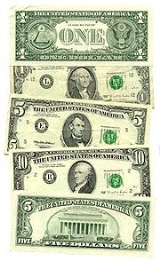
Federal Reserve Note
Overview
A Federal Reserve Note is a type of banknote
used in the United States of America. Federal Reserve Notes are printed by the United States Bureau of Engraving and Printing
on paper made by Crane & Co. of Dalton, Massachusetts
. They are the only type of U.S. banknote that is still produced today and they should not be confused with Federal Reserve Bank Note
s.
Federal Reserve Notes are authorized by Section 411 of Title 12 of the United States Code and are issued to the Federal Reserve Bank
s at the discretion of the Board of Governors of the Federal Reserve System.
Banknote
A banknote is a kind of negotiable instrument, a promissory note made by a bank payable to the bearer on demand, used as money, and in many jurisdictions is legal tender. In addition to coins, banknotes make up the cash or bearer forms of all modern fiat money...
used in the United States of America. Federal Reserve Notes are printed by the United States Bureau of Engraving and Printing
Bureau of Engraving and Printing
The Bureau of Engraving and Printing is a government agency within the United States Department of the Treasury that designs and produces a variety of security products for the United States government, most notable of which is paper currency for the Federal Reserve. The Federal Reserve itself is...
on paper made by Crane & Co. of Dalton, Massachusetts
Dalton, Massachusetts
Dalton is a town in Berkshire County, Massachusetts, United States. Dalton is the transition town between the urban and rural pieces of Berkshire County, Massachusetts. It is part of the Pittsfield, Massachusetts Metropolitan Statistical Area. The population was 6,892 at the 2000 census.- History...
. They are the only type of U.S. banknote that is still produced today and they should not be confused with Federal Reserve Bank Note
Federal Reserve Bank Note
Federal Reserve Bank Notes are legal tender in the United States, together with United States Notes, Silver Certificates, Gold Certificates, National Bank Notes and Federal Reserve Notes. They had the same value as other kinds of notes of similar face value...
s.
Federal Reserve Notes are authorized by Section 411 of Title 12 of the United States Code and are issued to the Federal Reserve Bank
Federal Reserve Bank
The twelve Federal Reserve Banks form a major part of the Federal Reserve System, the central banking system of the United States. The twelve federal reserve banks together divide the nation into twelve Federal Reserve Districts, the twelve banking districts created by the Federal Reserve Act of...
s at the discretion of the Board of Governors of the Federal Reserve System.

